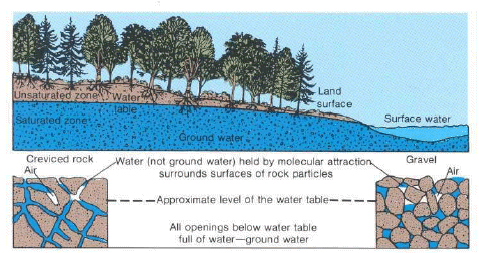Water Supply Wells
A well uses the groundwater in the rock under your property as a water supply. The system typically includes a narrow well (usually about 6 inches in diameter) with a submersible electric pump that connects directly to a home or business.

The well is drilled to a depth below the level of the water table so that the well shaft can store water for periods of higher-water demand. (The water table is that level in the ground below which the ground is saturated.) An impervious sleeve or casing lines the upper part of the well shaft to prevent surface water and shallow groundwater, which might contaminate the well water supply, from entering. As the pump removes water from the well shaft, groundwater flows in from fissures in the rock to replace what has been used (although not necessarily as quickly as it is withdrawn).
Depending on the volume of groundwater supplied or the quality of the groundwater, you might also need an aboveground storage/pressure tank or onsite water treatment. Current standards require that you identify two reserve well sites for future use in the event of a well failure. Wells must be sited at least 100 feet from and should be uphill from any existing or proposed septic system.

Illustration of Groundwater and the Water Table, Source: U.S. Geological Survey
Distribution in the County
The Department of Environmental Protection (DEP) estimates that approximately 17,500 properties in the county use an onsite well for their water supply. (Approximately 20,000 properties use a septic system for wastewater disposal.) Most of these onsite systems are found in large-lot residential and rural-zoned areas. As shown on the following map, areas served by onsite water supply wells tend towards the western and northern parts of the county. However, numerous wells still serve properties within the existing public water service areas, including locations where public water mains are available for service.
Montgomery County Public Water Service Areas and Well Locations
